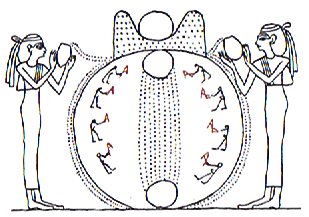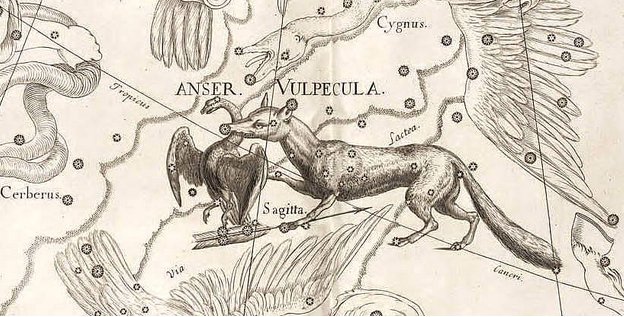107. Mother Earth (Land) was obviously female in character,
a woman (Lif) who would give birth (*) to new
life, who formed a bridge (Faka-taka)
between the generations. Whereas man was only
capable to end life (†), to pull down and destroy (Lif-thrasir).
...
There is a couple residing in one place
named Kui and Fakataka. After
the couple stay together for a while
Fakataka is pregnant. So they go away
because they wish to go to another place -
they go. The canoe goes and goes, the wind
roars, the sea churns, the canoe sinks.
Kui expires while Fakataka swims.
Fakataka
swims and swims, reaching another land. She
goes there and stays on the upraised reef in
the freshwater pools on the reef, and there
delivers her child, a boy child. She gives
him the name Taetagaloa. When the
baby is born a golden plover flies over and
alights upon the reef.
(Kua fanau
lā te pepe kae lele mai te tuli oi tū mai i
te papa).
And so the woman thus names various parts of
the child beginning with the name 'the
plover' (tuli): neck (tuliulu),
elbow (tulilima), knee (tulivae)
...

However, the stretch of Land between Naos and
Tarazed was not 7 (the mystic number of the Earth
Turtle) months but only 6 * 29˝ = 177 right ascension
days.
80 +
123 = 203 =
7 * 29.

|
Number of 'droplets' (rainy days) up in the Twin
Peak Mountain: |
| |
75 + 5 =
80 |
23 |
2 |
|
3 |
21 |
3 |
|
4 |
3 |
|
4 |
4 |
|
4 |
5 |
|
6 |
6 |
|
15 + 16 =
31 |
|
2 |
5 |
3 |
|
Number of 'droplets' down in the 9 Rivers: |
|
28 |
26 |
23 |
25 |
25 |
25 |
25 |
27 |
29 |
|
54 (= 9 * 6) |
123 |
56 (= 7 * 8) |
|
56 + 123 + 54 = 233 (= 313 - 80) |
|
Number of 'day droplets' from the
pair of Urns: |
|
16 |
30 |
80 |
18 |
9 |
|
14 |
9 |
|
30
+ 80
+
18
= 128 (= 2 * 64) |
|
|
|
|
|
|
107 |
14 |
|
|
|
4 |
|
66 |
127 |
45 |
|
61 |
48 |
|
30 + 127
=
157 (= 314 / 2) |
18 + 107
=
125 (= 5 * 5 * 5) |
|
157
+ 80
+
125
+ 4
= 366 =
6
* 47
+ 6 * 14 |
Altogether we can
perhaps perceive 233 (inside droplets
down in
the 9 rivers) + 366 (outside the
globe and in
the Twin Peak Mountain and in the
flows from the pair of Urns) = 599. This
number happens to be equal to the number
of glyphs on side a of the P tablet:
|
a1 |
53 |
53 |
b1 |
25 |
25 |
|
a2 |
59 |
112 |
b2 |
36 |
61 |
|
a3 |
62 |
174 |
b3 |
39 |
100 |
|
a4 |
61 |
235 |
b4 |
56 |
156 |
|
a5 |
80 |
315 |
b5 |
50 |
206 |
|
a6 |
60 |
375 |
b6 |
59 |
265 |
|
a7 |
58 |
433 |
b7 |
63 |
328 |
|
a8 |
55 |
488 |
b8 |
65 |
393 |
|
a9 |
42 |
530 |
b9 |
50 |
443 |
|
a10 |
36 |
566 |
b10 |
56 |
499 |
|
a11 |
33 |
599 |
b11 |
*61 |
*560 |
|
sum |
599 |
sum |
*560 |
Coincidence? The Golden
Plover carried 'droplets' on her back
and on top of her head. Ga2-26 is
glyph number 56 and the pair of 'inside rivers'
at right carried 29 + 27 = 7 * 8 = 56
'droplets'. And 56 + 123 = 179.
But then we should try to
count 26 + 28 = 54 (= 9 * 6) glyphs
ahead, beyond Ga7-10 (179). And 179 + 54
= 233:

|
NOV 6 |
7 |
8 (*232 = 8 * 29) |
9 |
10 (314) |
 |
 |
 |
 |
 |
|
Gb1-1 |
Gb1-2 |
Gb1-3 |
Gb1-4 (233) |
Gb1-5 |
|
INVISIBLY CLOSE TO THE SUN
(helical dates): |
|
DENEB OKAB
(Tail of the Eagle) = Δ Aquilae
(Ant.)
(294.0),
α Vulpeculae
(294.9) |
ν Aquilae (Ant.) (295.0),
ALBIREO = β Cygni
(295.5) |
ALSAFI = σ Draconis
(296.0), μ Aquilae (296.3), ι
Aquilae (Ant.) (296.8), κ
Aquilae (Ant.) (296.9) |
ε Sagittae
(297.1), σ Aquilae (Ant.)
(297.4),
SHAM
= α Sagittae
(297.8) |
β Sagittae (298.0), χ Aquilae
(298.3), ψ Aquilae (298.8) |
|
Jan 9 |
10 (*295) |
11 |
12 |
13 (378 = 7 * 54) |
|
°Jan 5 |
6 (*291) |
7 |
8 |
9 (374) |
|
LUCIA |
14 (*268) |
'Dec
15 |
16 (350 = 7 * 50) |
17 |
|
"Nov 29 |
30 (*254) |
"Dec 1 |
2 (336
= 7 * 48) |
3 |
|
... Thus the regular old Roman
year ended with Februarius 23
and it was 350 nights long, 25
fortnights. Then followed 5
extra nights, or as the Romans
saw it 5 + 1 = 6 nights in order
to include March 1, the first
day of the new regular year ...
 |
|
Side a
according to the heliacal
Gregorian calendar SIRIUS was at
°June 30 when NUNKI was close to
the Full Moon (cfr Ga2-11).
|
CLOSE TO THE FULL MOON (and
nakshatra dates): |
|
MAY 8 (493) |
9 (*49 = 7 * 7) |
10 (130) |
11 |
|
Ghost-23 (?)
ρ
Gemini (?) (112.1),
Eskimo Nebula = NGC2392 Gemini
(112.2)
ANTARES (α Scorpii)
|
Al Dhirā'-5 /
Punarvasu-7 /
Mash-mashu-Mahrū-10 (Western
One of the Twins)
CASTOR
= α Gemini
(113.4) |
ANA-TAHUA-VAHINE-O-TOA-TE-MANAVA-7
(Pillar for elocution)
υ
Gemini (114.0),
MARKAB PUPPIS = κ Puppis
(114.7), ο Gemini (114.8),
PROCYON = α Canis Minoris
(114.9) |
α MONOCEROTIS
(115.4), σ Gemini (115.7) |
|
Side b
at the time of Julius Caesar
SIRIUS was at 'June 30 when
ROTTEN MELON was close to the
Full Moon (cfr Gb1-18). |
|
July 11 |
12 (193) |
13 |
14 (*480) |
|
°July 7 (188) |
8 |
9 |
10 (*111) |
|
'June 14 |
15 (166) |
16 |
17 (*88) |
|
"May 31 |
Maro 1 (152) |
2 (*63) |
3 |
 |
 |
 |
 |
 |
|
Ga2-17 |
Ga2-18 |
Ga2-19 |
Ga2-20 (50) |
Ga2-21 |

|




 1 winter solstice
1 winter solstice

























